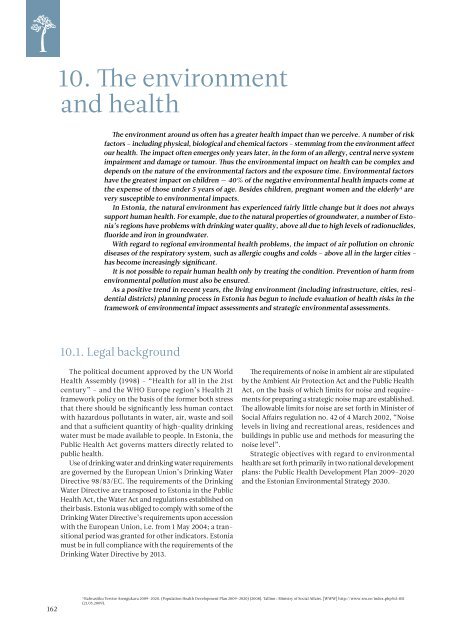ESTONIAN ENVIRONMENTAL REVIEW 2009
ESTONIAN ENVIRONMENTAL REVIEW 2009
ESTONIAN ENVIRONMENTAL REVIEW 2009
Create successful ePaper yourself
Turn your PDF publications into a flip-book with our unique Google optimized e-Paper software.
10. The environment<br />
and health<br />
The environment around us often has a greater health impact than we perceive. A number of risk<br />
factors – including physical, biological and chemical factors – stemming from the environment affect<br />
our health. The impact often emerges only years later, in the form of an allergy, central nerve system<br />
impairment and damage or tumour. Thus the environmental impact on health can be complex and<br />
depends on the nature of the environmental factors and the exposure time. Environmental factors<br />
have the greatest impact on children — 40% of the negative environmental health impacts come at<br />
the expense of those under 5 years of age. Besides children, pregnant women and the elderly A are<br />
very susceptible to environmental impacts.<br />
In Estonia, the natural environment has experienced fairly little change but it does not always<br />
support human health. For example, due to the natural properties of groundwater, a number of Estonia’s<br />
regions have problems with drinking water quality, above all due to high levels of radionuclides,<br />
fluoride and iron in groundwater.<br />
With regard to regional environmental health problems, the impact of air pollution on chronic<br />
diseases of the respiratory system, such as allergic coughs and colds – above all in the larger cities –<br />
has become increasingly significant.<br />
It is not possible to repair human health only by treating the condition. Prevention of harm from<br />
environmental pollution must also be ensured.<br />
As a positive trend in recent years, the living environment (including infrastructure, cities, residential<br />
districts) planning process in Estonia has begun to include evaluation of health risks in the<br />
framework of environmental impact assessments and strategic environmental assessments.<br />
10.1. Legal background<br />
The political document approved by the UN World<br />
Health Assembly (1998) – “Health for all in the 21st<br />
century” – and the WHO Europe region’s Health 21<br />
framework policy on the basis of the former both stress<br />
that there should be significantly less human contact<br />
with hazardous pollutants in water, air, waste and soil<br />
and that a sufficient quantity of high-quality drinking<br />
water must be made available to people. In Estonia, the<br />
Public Health Act governs matters directly related to<br />
public health.<br />
Use of drinking water and drinking water requirements<br />
are governed by the European Union’s Drinking Water<br />
Directive 98/83/EC. The requirements of the Drinking<br />
Water Directive are transposed to Estonia in the Public<br />
Health Act, the Water Act and regulations established on<br />
their basis. Estonia was obliged to comply with some of the<br />
Drinking Water Directive’s requirements upon accession<br />
with the European Union, i.e. from 1 May 2004; a transitional<br />
period was granted for other indicators. Estonia<br />
must be in full compliance with the requirements of the<br />
Drinking Water Directive by 2013.<br />
The requirements of noise in ambient air are stipulated<br />
by the Ambient Air Protection Act and the Public Health<br />
Act, on the basis of which limits for noise and requirements<br />
for preparing a strategic noise map are established.<br />
The allowable limits for noise are set forth in Minister of<br />
Social Affairs regulation no. 42 of 4 March 2002, “Noise<br />
levels in living and recreational areas, residences and<br />
buildings in public use and methods for measuring the<br />
noise level”.<br />
Strategic objectives with regard to environmental<br />
health are set forth primarily in two national development<br />
plans: the Public Health Development Plan <strong>2009</strong>–2020<br />
and the Estonian Environmental Strategy 2030.<br />
162<br />
A<br />
Rahvastiku Tervise Arengukava <strong>2009</strong>–2020. (Population Health Development Plan <strong>2009</strong>–2020) (2008). Tallinn : Ministry of Social Affairs. [WWW] http://www.sm.ee/index.php?id=851<br />
(21.05.<strong>2009</strong>).

















